Monthly Summaries
Issue 26, February 2019
[DOI]
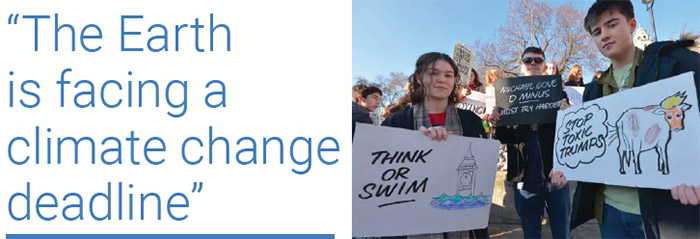
Students from Graveney School in Tooting, south London, join the protest in Westminster. Photo: Nick Ansell/PA.
February media attention to climate change and global warming was up 9% throughout the world from the previous month of January, and up 63% from February 2018.
While Asia, Middle East and Central/South America coverage was down 8%, 12% and 15% respectively from the previous month, it was up in all other regions. For examples, coverage in Europe was up 8%, Oceania coverage increased 34% and North America media attention went up 8% in February compared to the previous month.
Figure 1 shows increases and decreases in newspaper media coverage at the global scale – organized into seven geographical regions around the world – from January 2004 through February 2019.
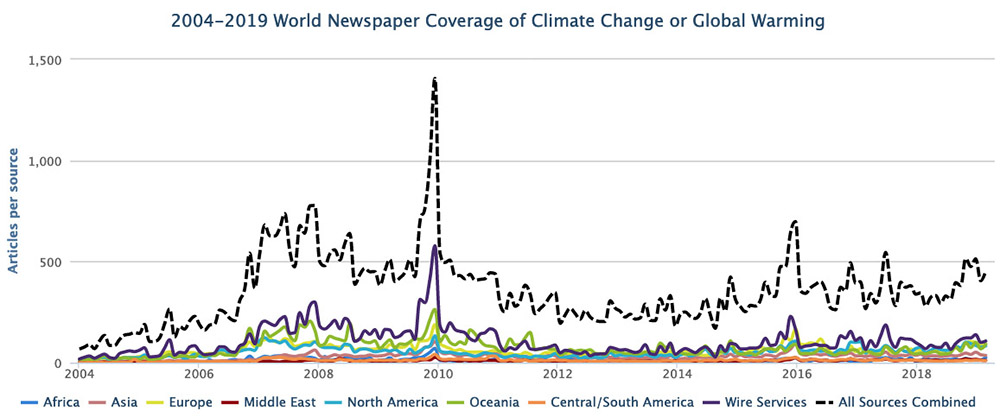
Figure 1. Newspaper media coverage of climate change or global warming in sixty-six sources across thirty-six countries in seven different regions around the world, from January 2004 through February 2019.
Figure 2 shows word frequency data in United States (US) newspaper media coverage in both January 2019 and February 2019. Despite a waning Trump influence in January (see word cloud depiction in Figure 2, left), his influence in media coverage in the US returned in February (see word cloud depiction in Figure 2, right). The slow disappearing feature of a ‘Trump Dump’ (where media attention that would have focused on other climate-related events and issues instead was placed on Trump-related actions, leaving many other stories untold) was counteracted by Trump Administration (in)action in the month of February, such as an absence of mention of climate change in his State of the Union address (that sparked media remarks) and the presence of Trump Administration critiques of the proposed ‘Green New Deal’ (see below for more).
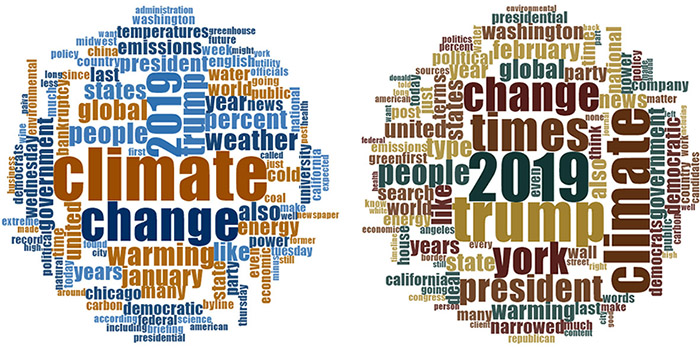
Figure 2. Word cloud showing frequency of words (4 letters or more) invoked in media coverage of climate change or global warming in United States newspaper sources in January (left) and February (right). Data are from the Los Angeles Times, The New York Times, USA Today, The Wall Street Journal and The Washington Post.
 In February, there were many media stories about climate change that touched on political and economic content. In the US, committee hearings in the House of Representatives generated considerable media attention in early February. In particular, a hearing in the US House of Representatives’ Committee on Natural Resources on climate change, and a subcommittee hearing in the Energy and Commerce Committee on the economic impacts of climate change generated media attention. For example, MSNBC ran with the headline ‘The House – finally – cares about climate change again’ while journalist Jen Christensen from CNN noted, “President Donald Trump did not mention climate change or any efforts to help the environment during his State of the Union address Tuesday, but members of the US House of Representatives held two hearings Wednesday on Capitol Hill to take a closer look at the threat of climate change”. Stephanie Ebbs from ABC News reported on dueling personalities in the hearings when she noted, “ranking Member Rob Bishop, R-Utah, raised concerns the hearing was too broad and not focused enough on the committee's jurisdiction, which is federal conservation programs. Bishop said he wants to the committee to spend more time talking about how forests can be managed to promote clean air and protect states from smoke pollution as a result of wildfires in states like California…"I have to mention I'm kind of a loss, I don't know where this hearing is going or the other six you have planned because you haven't told us what the goal is. At some point we may be asking, where are we going? What is the real legislation to help people that is supposed to come out of these hearings? To understand whether these hearings are for those of us around the horseshoe that are going to make legislation or this group that's sitting at a table in the corner so they can write cute stories," Bishop said, point toward reporters in the hearing room”.
In February, there were many media stories about climate change that touched on political and economic content. In the US, committee hearings in the House of Representatives generated considerable media attention in early February. In particular, a hearing in the US House of Representatives’ Committee on Natural Resources on climate change, and a subcommittee hearing in the Energy and Commerce Committee on the economic impacts of climate change generated media attention. For example, MSNBC ran with the headline ‘The House – finally – cares about climate change again’ while journalist Jen Christensen from CNN noted, “President Donald Trump did not mention climate change or any efforts to help the environment during his State of the Union address Tuesday, but members of the US House of Representatives held two hearings Wednesday on Capitol Hill to take a closer look at the threat of climate change”. Stephanie Ebbs from ABC News reported on dueling personalities in the hearings when she noted, “ranking Member Rob Bishop, R-Utah, raised concerns the hearing was too broad and not focused enough on the committee's jurisdiction, which is federal conservation programs. Bishop said he wants to the committee to spend more time talking about how forests can be managed to promote clean air and protect states from smoke pollution as a result of wildfires in states like California…"I have to mention I'm kind of a loss, I don't know where this hearing is going or the other six you have planned because you haven't told us what the goal is. At some point we may be asking, where are we going? What is the real legislation to help people that is supposed to come out of these hearings? To understand whether these hearings are for those of us around the horseshoe that are going to make legislation or this group that's sitting at a table in the corner so they can write cute stories," Bishop said, point toward reporters in the hearing room”.
There was a lot of political coverage relating to the Green New Deal – co-sponsored by Rep. Alexandria Ocasio-Cortez (D-NY) and Sen. Edward Markey (D-MA) – in February. This legislation was touted as “a ten-year plan to mobilize every aspect of American society at a scale not seen since World War II to achieve net-zero greenhouse gas emissions and create economic prosperity for all". Journalists Lisa Friedman and Glenn Thrush from The New York Times reported, “Liberal Democrats put flesh on their “Green New Deal” slogan on Thursday with a sweeping resolution intended to redefine the national debate on climate change by calling for the United States to eliminate additional emissions of carbon by 2030. The measure, drafted by freshman Representative Alexandria Ocasio-Cortez of New York and Senator Edward J. Markey of Massachusetts, is intended to answer the demand, by the party’s restive base, for a grand strategy that combats climate change, creates jobs and offers an affirmative response to the challenge to core party values posed by President Trump…as a blueprint for liberal ambition, it was breathtaking. It includes a 10-year commitment to convert “100 percent of the power demand in the United States” to “clean, renewable and zero-emission energy sources,” to upgrade “all existing buildings” to meet energy efficiency requirements, and to expand high-speed rail so broadly that most air travel would be rendered obsolete. The initiative, introduced as nonbinding resolutions in the House and Senate, is tethered to an infrastructure program that its authors say could create millions of new “green jobs,” while guaranteeing health care, “a family-sustaining wage, adequate family and medical leave, paid vacations and retirement security” to every American”. Meanwhile, USA Today reporters Elizabeth Weise and Ledyard King noted, “The Earth is facing a climate change deadline, with a looming tipping point into a dramatically changed, less hospitable planet – and Democratic lawmakers are beginning what's likely to be a long discussion over how best to deal with it. These first attempts have coalesced under a Green New Deal championed by Rep. Alexandria Ocasio-Cortez, D-N.Y., and Sen. Edward Markey, D-Mass”. As an illustration on US television, Amna Nawaz and William Brangham from PBS Newshour discussed the scale and scope of the plan with co-sponsoring US Senator Ed Markey.
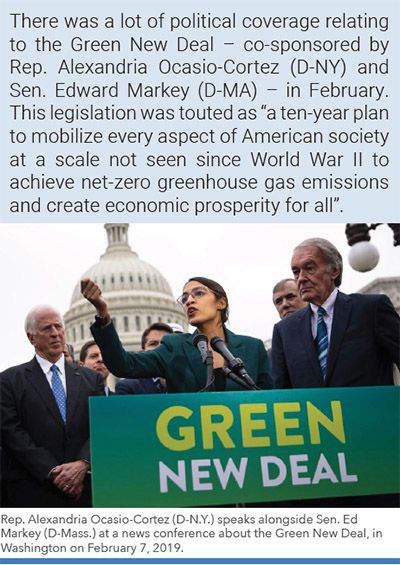 In addition, a new ‘scorecard’ from the League of Conservation Voters was released late in the month, and this generated additional media attention in the US. It found that the differences in positions taken on climate change between Democrats and Republicans is stark, where the former has increasingly engaged with the issue over the past year. For example, journalist Dino Grandoni from The Washington Post reported “Democratic voters will have to decide among a slate of White House hopefuls tripping over themselves to commit to tackling climate change and other environmental issues. But which Democratic senator had the best environmental voting record in Congress last year? The answer: all of them. Each senator who has announced their candidacy for president received perfect scores in an annual voting scorecard kept by the League of Conservation Voters. The six declared 2020 candidates in the Senate — Sens. Cory Booker (D-N.J.), Kirsten Gillibrand (D-N.Y.), Kamala Harris (D-Calif.), Amy Klobuchar (D-Minn.), Bernie Sanders (I-Vt.), Elizabeth Warren (D-Mass.) — always aligned with positions the environmental organization deemed ‘pro-environment’. So too did a handful of Senate Democrats thought to be considering a run for president, including Michael Bennet (D-Colo.), Sherrod Brown (D-Ohio) and Jeff Merkley (D-Ore.)”.
In addition, a new ‘scorecard’ from the League of Conservation Voters was released late in the month, and this generated additional media attention in the US. It found that the differences in positions taken on climate change between Democrats and Republicans is stark, where the former has increasingly engaged with the issue over the past year. For example, journalist Dino Grandoni from The Washington Post reported “Democratic voters will have to decide among a slate of White House hopefuls tripping over themselves to commit to tackling climate change and other environmental issues. But which Democratic senator had the best environmental voting record in Congress last year? The answer: all of them. Each senator who has announced their candidacy for president received perfect scores in an annual voting scorecard kept by the League of Conservation Voters. The six declared 2020 candidates in the Senate — Sens. Cory Booker (D-N.J.), Kirsten Gillibrand (D-N.Y.), Kamala Harris (D-Calif.), Amy Klobuchar (D-Minn.), Bernie Sanders (I-Vt.), Elizabeth Warren (D-Mass.) — always aligned with positions the environmental organization deemed ‘pro-environment’. So too did a handful of Senate Democrats thought to be considering a run for president, including Michael Bennet (D-Colo.), Sherrod Brown (D-Ohio) and Jeff Merkley (D-Ore.)”.
Also in February, media covered ecological and meteorological dimensions of climate issues. For example (intersecting with scientific coverage), public understanding and awareness of links between extreme weather and climate change was assessed in a Proceedings of the Natural Academy of Sciences study that garnered media attention in February. Through their research, the authors posited that over a period of approximately five years, what was considered once-extreme weather tends to become unremarkable and ‘normal’ weather. As an example of coverage, CNN journalist Jen Christensen reported, “The extreme weather that comes with climate change is becoming the new normal, so normal that people aren't talking about it as much -- and that could make them less motivated to take steps to fight global warming, according to new research. Researchers analyzed more than 2 billion social media posts between 2014 and 2016. What they found was that, when temperatures were unusual for a particular time of year, people would comment on it at first. But if the temperature trend continued and there were unusual temperatures again at that time the following year, people stopped commenting as much”.
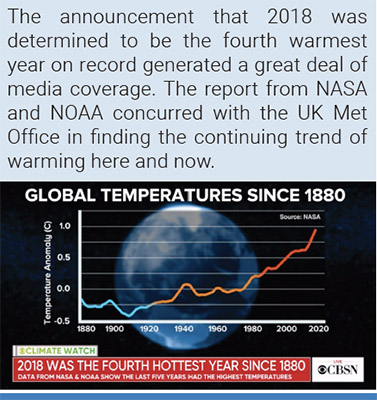 Regarding media accounts focused on primarily scientific dimensions of climate change and global warming, the announcement that 2018 was determined to be the fourth warmest year on record generated a great deal of media coverage. The report from NASA and NOAA concurred with the UK Met Office in finding the continuing trend of warming here and now. As an example of coverage, Wall Street Journal journalist Timothy Puko reported, “The past five years have been the hottest in modern records…Last year was the fourth-warmest year since 1880, according to the report by the National Aeronautics and Space Administration and the National Oceanic and Atmospheric Administration, which track annual climate trends”. Reporter Jonathan Watts at The Guardian wrote, “Global warming could temporarily hit 1.5C above pre-industrial levels for the first time between now and 2023”. CBS News added that “the average temperature for the contiguous U.S. in 2018 was 53.5 degrees Fahrenheit, making it a warmer-than-average year for the 22nd year in a row”.
Regarding media accounts focused on primarily scientific dimensions of climate change and global warming, the announcement that 2018 was determined to be the fourth warmest year on record generated a great deal of media coverage. The report from NASA and NOAA concurred with the UK Met Office in finding the continuing trend of warming here and now. As an example of coverage, Wall Street Journal journalist Timothy Puko reported, “The past five years have been the hottest in modern records…Last year was the fourth-warmest year since 1880, according to the report by the National Aeronautics and Space Administration and the National Oceanic and Atmospheric Administration, which track annual climate trends”. Reporter Jonathan Watts at The Guardian wrote, “Global warming could temporarily hit 1.5C above pre-industrial levels for the first time between now and 2023”. CBS News added that “the average temperature for the contiguous U.S. in 2018 was 53.5 degrees Fahrenheit, making it a warmer-than-average year for the 22nd year in a row”.
Also, a study in February from the journal Biological Conservation by Francisco Sánchez-Bayo and Kris Wyckhuis earned considerable media attention. This article reported that many insect populations worldwide are declining at a rapid rate and 40% of species are at risk for extinction within the century. For example, BBC journalist Aylin Woodward provided stark reporting, beginning an article “Somehow, it's easier to be concerned about wolves, sea turtles, and white rhinos dying off than it is to feel remorse over vanishing bugs. But the loss of insects is a dire threat — one that could trigger a "catastrophic collapse of Earth's ecosystems," a new study said. The research, the first global review of its kind, looked at 73 historical reports on insect declines around the world and found the total mass of all insects on the planets is decreasing by 2.5% per year. If this trend continues unabated, the Earth may not have any insects at all by 2119”.
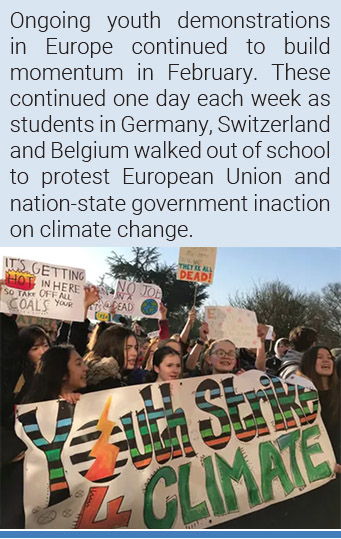 Across the globe in February, there was a range of stories that intersected with the cultural arena. For example, there was news coverage (melding with political and economic coverage) of the development that Exxon Mobil has plans to partner with Qatar's national energy company to build a $10 billion natural gas export hub in Texas. Journalist Clifford Kraus from The New York Times noted, “Qatar Petroleum and Exxon Mobil said on Tuesday that they are making a big investment in American natural gas exports. The deal is designed in part to strengthen Qatar’s ties with the United States nearly two years after Saudi Arabia and its allies launched a trade embargo against the country. The companies said they would spend more than $10 billion to turn Golden Pass, a terminal in Texas originally built to import gas, into an export hub for gas extracted from shale fields in Texas, New Mexico and elsewhere. A deeper push into the United States would give state-owned Qatar Petroleum, already the biggest liquefied natural gas exporter in the world, quicker and cheaper access to Latin America, freeing more of its domestic production for lucrative Asian markets. Qatar is also making a bid to strengthen its relationship with the Trump administration, which has established close ties with Saudi Arabia”.
Across the globe in February, there was a range of stories that intersected with the cultural arena. For example, there was news coverage (melding with political and economic coverage) of the development that Exxon Mobil has plans to partner with Qatar's national energy company to build a $10 billion natural gas export hub in Texas. Journalist Clifford Kraus from The New York Times noted, “Qatar Petroleum and Exxon Mobil said on Tuesday that they are making a big investment in American natural gas exports. The deal is designed in part to strengthen Qatar’s ties with the United States nearly two years after Saudi Arabia and its allies launched a trade embargo against the country. The companies said they would spend more than $10 billion to turn Golden Pass, a terminal in Texas originally built to import gas, into an export hub for gas extracted from shale fields in Texas, New Mexico and elsewhere. A deeper push into the United States would give state-owned Qatar Petroleum, already the biggest liquefied natural gas exporter in the world, quicker and cheaper access to Latin America, freeing more of its domestic production for lucrative Asian markets. Qatar is also making a bid to strengthen its relationship with the Trump administration, which has established close ties with Saudi Arabia”.
Also, ongoing youth demonstrations in Europe continued to build momentum in February. These continued one day each week as students in Germany, Switzerland and Belgium walked out of school to protest European Union and nation-state government inaction on climate change. In February, media covered its spread to the UK and elsewhere. On February 15, Guardian journalists Matthew Taylor, Sandra Laville, Amy Walker and Poppy Noor reported, “Thousands of schoolchildren and young people in the UK have taken part in climate strikes with the support of a former UN climate chief, who said it was “time to heed the deeply moving voice of youth”. Christiana Figueres, who led the historic 2015 Paris agreement, said the fact that children were so worried about their future they were prepared to strike should make adults take urgent action. “It is a sign that we are failing in our responsibility to protect them from the worsening impacts of climate change,” she said. Initial reports suggested several thousand children walked out of lessons on Friday in protest at the mounting ecological crisis. Organisers said 3,000 had gathered in London, 2,000 in Oxford, 1,000 in Leeds and Exeter and 600 in Brighton”.
Also relating to cultural stories (and themes permeating other themes above), issues of race, socio-economics, justice and (in)equality have permeated reporting in February. For example, journalist Tracy Jan from The Washington Post reported “Race appears to trump ethnicity when it comes to predicting wealth, according to a new report examining the economic disparities among Miami’s diverse population. Among the most provocative findings: Identifying as black or white was a bigger factor than ancestry or ethnicity in determining employment, income and homeownership… Descendants of black Americans, Afro-Caribbeans — primarily Haitians, Jamaicans, Trinidadians and Tobagonians — and black Latinos were more economically similar than Latinos of various ancestry who identified as white, the researchers found. The median wealth for U.S. black households was $3,700, compared with $12,000 for black Caribbean households and $107,000 for white households, the study found. Latinos who identified as white generally have higher household incomes and homeownership rates and lower unemployment rates than those of black Latinos, the study found”. This was a Kirwani Institute for the Study of Race and Ethnicity at Ohio State University report, authored by nine researchers.
We at MeCCO will continue to monitor and analyze ongoing political, economic, ecological, meteorological, cultural and scientific dimensions of climate change as they are represented in the media in 2019. Stay tuned in.
